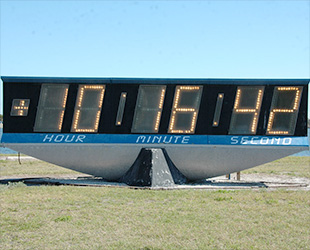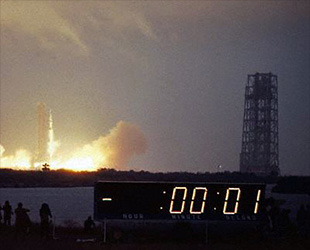October 1, 2014– The countdown is now underway for the removal and replacement of the historic launch countdown clock at NASA's Kennedy Space Center in Florida.
The large digital clock, which has stood for more than four decades outside the center's press site, ticking down the hours, minutes and seconds remaining to the next launch, is being replaced with a more capable, modern display like the screens used in ballparks or in New York City's Times Square.
"We are looking at [installing] a bigger screen that will look more modern," said Lisa Malone, director of public affairs at Kennedy Space Center. "It will be more flexible, so we'll be able to show the countdown, as well as have additional room to show NASA TV programming, too."
The original clock used 40-watt light bulbs to form digits and either a plus or minus sign to count down or up from the time of a launch. Painted black with blue trim, the 26-foot-long (8-meter) clock stands 10 feet (3 meters) at its tallest point.

The black with blue trim, 26-foot-long clock displayed the hours, minutes and seconds to a launch using lightbulbs to form digits. |
The decision now to replace the countdown clock was not driven by aesthetics or capability alone, Malone explained. Though iconic — over the years, the clock was frequently seen in the foreground of rocket and space shuttle launch photographs and footage — it was increasingly difficult to maintain.
"The clock is made of parts that are no longer being made and so it is harder and harder to keep it running," Malone told collectSPACE.
Though some NASA's records indicate the clock may date back to 1967, archival photos show it was absent from its location at the northeast corner of the press site until the launch of Apollo 12, the second moon landing mission, in November 1969. It was then in use for the remaining six Saturn V launches, four Saturn IB rocket launches and all 135 space shuttle missions through 2011.
In more recent years, the clock was also used to display the time leading up and through numerous planetary probe and uncrewed NASA launches. Most recently, it was used for the Sept. 25 liftoff of a commercial resupply mission to the International Space Station.

The countdown clock ticks down the last second during its first launch, the Nov. 14, 1969 liftoff of Apollo 12. (Bettmann) |
By the time of NASA's next launch from Florida however, the historic clock may already be replaced. The agency is targeting Dec. 4 for Exploration Flight Test-1 (EFT-1), the first test flight of its next generation crew capsule, Orion.
"Our goal is to have it in place by EFT-1," Malone said. "I am really hopeful that we are going to be able to get the new clock in place by then."
"I think it is going to be a really tight timeline to make that happen and get it hooked up and ready to go," she added.
Still, Malone noted, they don't want to rush the removal of the original clock given its status on the National Register of Historic Places. NASA has completed documenting and photographing it for posterity, but care will still be taken to make sure it is not damaged.
"Because it is a historic piece, we want to make sure it is removed intact," she said.
The curators at the Smithsonian in Washington, D.C. have expressed their interest in the original clock, Malone said, but NASA's plan as of now is to transfer it to the Kennedy Space Center Visitor Complex. There, it will eventually be placed on public display.
